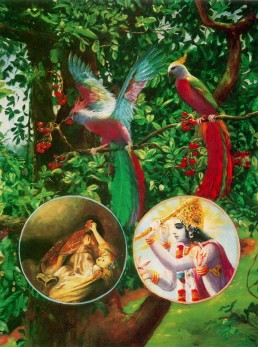Swami Chinmayananda
Swami Chinmayananda Commentary
The difference between the microcosm and the macrocosm is the difference in the equipments through which the same Truth, the Eternal and the All-perfect, expresses. When life surges through the Cosmic-Mind, It (Ishwara) comes to project out the entire Universe-of-plurality; and when the same Infinite expresses through an individual-mind, it (Jiva) projects out the individual-world. In both these manifestations — the God-principle (Ishwara) and the individual ego (Jiva) — the Essence is one and the same, just as, for the manifestation of light-in-the-bulb and heat-in-the-heater, the energy is one and the same, i. e., electricity. In electricity, considered as pure energy, there is neither light nor heat. In the same way, in the Pure Self, in its Essential Nature, there is neither the God nor the ego. He who realises this “IN REALITY,” we are told, will become established in the Supreme Awareness through the “TREMORLESS-YOGA.”
We prepare a ball of mud of the required plasticity from a sample of mud after kneading it properly with water. The ball of mud is next put on the potter’s wheel and roughly shaped. In the third stage, the pot is finished, dried and polished. And in the fourth stage, the pots so made are baked and painted. The mud can certainly insist that it is the ‘origin and essence’ of the pot, and that it is only in the mud that the four stages of the pot’s evolution had taken place and are never divorced from it. This is true for all mud-pots at all times; none of them has any existence, growth, or development, without the mud which is the sustaining material in all of them. So too, the same Principle in its different manifestations becomes Ishwara and Jiva.
An individual, whose intellect is soaked with discriminative awareness — of the subtle difference between the cosmic and the individual — is alone capable of turning his mind away from the created world-of-objects, and towards the one and the same Subjective Reality, both in the Creator and in himself. The attitude of a mind successfully employing itself in this inward quest is being indicated here by the pregnant term “with loving consciousness” (Bhaava samanvitah).
Love, or devotion, is measured by the capacity of the lover to identify himself with the beloved. In short, love is fulfilled when identification is complete, and when the devotee is capable of experiencing in himself that he is none other than the Infinite Self which, functioning through the Cosmic-mind, plays the part of the Ishwara, the Creator, and, which, when functioning through an individual-mind-intellect equipment, behaves as though It is the Jiva, the limited ego.
What has been asserted courageously in the previous stanza has been systematically developed here into a technique by which the above-mentioned experience can be brought within the intimate personal comprehension of every student.
Adi Sankara Commentary
Aham, I, the supreme Brahman called Vasudeva; am the prabhavah, origin; sarvasya, of all, of the whole world; sarvam, everything, the whole world of changes, consisting of continuance, destruction, action and enjoyment of the fruits of action; pravartate, moves on; mattah, owing to Me alone. Matva, realizing; iti, thus; the budhah, wise ones, the knowers of the supreme Reality; bhava-samanvitah, filled with fervour-bhava is the same as bhavana, meaning ardent longing for the supreme Reality; filled (samanvitah) with that, i.e. imbued with that; bhajante, adore; mam, Me. Besides,
The Bhagavad Gita with the commentary of Sri Sankaracharya – Translated by Alladi Mahadeva Sastry
Holy Geeta – Commentary by Swami Chinmayananda
The Bhagavad Gita by Eknath Easwaran – Best selling translation of the Bhagavad Gita
The Bhagavad Gita – Translation and Commentary by Swami Sivananda
Bhagavad Gita – Translation and Commentary by Bhaktivedanta Swami Prabupadha
Srimad Bhagavad Gita Chapter 10 – Verse 8 – 10.8 aham sarvasya – All Bhagavad Gita (Geeta) Verses in Sanskrit, English, Transliteration, Word Meaning, Translation, Audio, Shankara Bhashya, Adi Sankaracharya Commentary and Links to Videos by Swami Chinmayananda and others – 10-8

